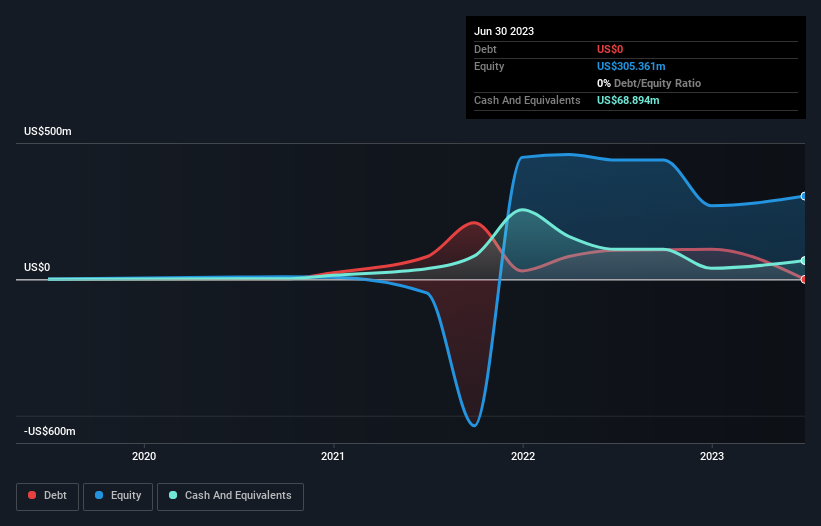- United States
- /
- Software
- /
- NasdaqGS:IREN
We're Not Very Worried About Iris Energy's (NASDAQ:IREN) Cash Burn Rate

Even when a business is losing money, it's possible for shareholders to make money if they buy a good business at the right price. Indeed, Iris Energy (NASDAQ:IREN) stock is up 118% in the last year, providing strong gains for shareholders. But while the successes are well known, investors should not ignore the very many unprofitable companies that simply burn through all their cash and collapse.
In light of its strong share price run, we think now is a good time to investigate how risky Iris Energy's cash burn is. In this report, we will consider the company's annual negative free cash flow, henceforth referring to it as the 'cash burn'. The first step is to compare its cash burn with its cash reserves, to give us its 'cash runway'.
View our latest analysis for Iris Energy
How Long Is Iris Energy's Cash Runway?
A company's cash runway is calculated by dividing its cash hoard by its cash burn. When Iris Energy last reported its balance sheet in June 2023, it had zero debt and cash worth US$69m. Importantly, its cash burn was US$110m over the trailing twelve months. That means it had a cash runway of around 8 months as of June 2023. Notably, analysts forecast that Iris Energy will break even (at a free cash flow level) in about 18 months. That means unless the company reduces its cash burn quickly, it may well look to raise more cash. Depicted below, you can see how its cash holdings have changed over time.

How Well Is Iris Energy Growing?
Happily, Iris Energy is travelling in the right direction when it comes to its cash burn, which is down 60% over the last year. Pleasingly, this was achieved with the help of a 28% boost to revenue. We think it is growing rather well, upon reflection. Clearly, however, the crucial factor is whether the company will grow its business going forward. So you might want to take a peek at how much the company is expected to grow in the next few years.
How Hard Would It Be For Iris Energy To Raise More Cash For Growth?
While Iris Energy seems to be in a fairly good position, it's still worth considering how easily it could raise more cash, even just to fuel faster growth. Issuing new shares, or taking on debt, are the most common ways for a listed company to raise more money for its business. One of the main advantages held by publicly listed companies is that they can sell shares to investors to raise cash and fund growth. By comparing a company's annual cash burn to its total market capitalisation, we can estimate roughly how many shares it would have to issue in order to run the company for another year (at the same burn rate).
Iris Energy's cash burn of US$110m is about 34% of its US$328m market capitalisation. That's fairly notable cash burn, so if the company had to sell shares to cover the cost of another year's operations, shareholders would suffer some costly dilution.
How Risky Is Iris Energy's Cash Burn Situation?
On this analysis of Iris Energy's cash burn, we think its cash burn reduction was reassuring, while its cash runway has us a bit worried. There's no doubt that shareholders can take a lot of heart from the fact that analysts are forecasting it will reach breakeven before too long. Cash burning companies are always on the riskier side of things, but after considering all of the factors discussed in this short piece, we're not too worried about its rate of cash burn. On another note, Iris Energy has 3 warning signs (and 2 which are significant) we think you should know about.
If you would prefer to check out another company with better fundamentals, then do not miss this free list of interesting companies, that have HIGH return on equity and low debt or this list of stocks which are all forecast to grow.
New: AI Stock Screener & Alerts
Our new AI Stock Screener scans the market every day to uncover opportunities.
• Dividend Powerhouses (3%+ Yield)
• Undervalued Small Caps with Insider Buying
• High growth Tech and AI Companies
Or build your own from over 50 metrics.
Have feedback on this article? Concerned about the content? Get in touch with us directly. Alternatively, email editorial-team (at) simplywallst.com.
This article by Simply Wall St is general in nature. We provide commentary based on historical data and analyst forecasts only using an unbiased methodology and our articles are not intended to be financial advice. It does not constitute a recommendation to buy or sell any stock, and does not take account of your objectives, or your financial situation. We aim to bring you long-term focused analysis driven by fundamental data. Note that our analysis may not factor in the latest price-sensitive company announcements or qualitative material. Simply Wall St has no position in any stocks mentioned.
About NasdaqGS:IREN
High growth potential with adequate balance sheet.


